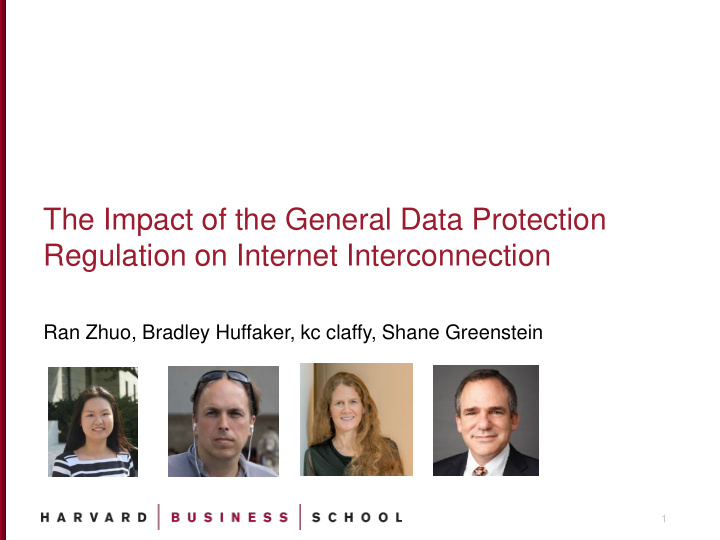



The Impact of the General Data Protection Regulation on Internet Interconnection Ran Zhuo, Bradley Huffaker, kc claffy, Shane Greenstein 1
Research Question How does the GDPR affect investment in growing and interconnecting the internet layer of the Internet? (A quick overview) 2
Why care about GDPR and interconnection? GDPR is the most important policy initiative in last two decades. Inspiring similar laws in many other countries and some US states. All but one (limited) study identifies large costs associated with GDPR at the application layer. Nobody looked at network layer, as we do. Many news articles & popular discussion about GDPR. Again, all focused on large implementation costs/distortions of GDPR. Concern: Reasoning from select example. What happens widely? Theoretical intuition: prediction that costs at application layer would lead to visible changes in interconnection at the internet layer. 3
What this study does: Examine interconnection • Theoretical model to formalize intuition. • For the economists among the readers • “Difference in a difference” statistics. • First difference: Before & after GDPR • Second difference b/w treatment & control: • Treatment: Networks in developed countries who adopt GDPR. Control: Networks in developed (OECD) countries w/o GDPR. • Three samples for comparison (a), (b), (c). • Every which way on available CAIDA data. • Use CAIDA data on interconnection 4
What network features do we examine? • N of agreements for a network • N of agreements for each country • N of agreement for each country pair • Provider to customer • Peer to peer • Customer to provider • N of IP-address-level interconnection points b/w network pair, conditional on an agreement • N of networks w/HQ in country • N of networks a network can reach through its customers 5
What the study finds Overall growth, and at a similar rate for treated and control before GDPR, so research question boils down to simple statistical test: do treated networks grow more slowly than control after GDPR? Find no statistically significant change in the connections at any measurable margin. • Robust statistical finding: No evidence of costs from GDPR at the interconnection layer • Interpretation: All the costs of GDPR are borne at the application layer. • Interpretation: All costs of GDPR borne by some of the value creating companies in the economy. 6
Theory Due to time constraints we will skip the theory section. Theoretical intuition: prediction that costs at application layer would lead to visible changes in interconnection at the internet layer. Let’s move straight to the data results. 7
Illustration & intuition (Figure 3) • Compare log number of agreements Figure 3 associated with each network, comparing b/w networks in EEA, and OECD-non-EEA areas. • Note parallel growth. • Visually similar during pre-trend, between announcement and implementation, and after implementation. • Regression does the diff-in-diff on monthly data, with network dummies, and month dummies no statistical difference. 8
Same result: interconnection (Figure 4) a c b The number of interconnection agreements between pairs of networks owned by networks with HQ in the countries i and j. With the three samples of pairs: (a) Provider to customer; (b) Peer to peer; (c) Customer to provider. 9
Same result for type of agreement (Figure 5) 1 3 2 Compare EEA networks with OECD-non-EEA networks. The number of interconnection agreements (1) where country i’s network is a provider to country j’s network; (2) where country i’s network and country j’s network are peers; (3) where country i’s network is a customer of country j’s network. 10
Same result for IP connections (Figure 6) a c b The number of IP-address-level interconnection points between network k and network l, given k and l have an agreement. With the three sample pairs: (a) Provider to customer; (b) Peer to peer; (c) Customer to provider. (Yes, the data on agreements with non-EEA & non-OECD is quite noisy) 11
Same result: Number of networks, and the cone of the networks (Figures 7 & 8) The number of networks The number of networks owned by network k can reach through its companies with HQ in country i. customer connections alone. 12
Conclusion No evidence of costs from GDPR at the interconnection layer we set a benchmark against which all later changes can be measured. • Interpretation: All the costs of GDPR are borne at the application layer. More interpretation: All costs of GDPR borne by the value creating companies in the economy. • Interpretation: The effect of GDPR on traffic growth and agreements is small compared to all other things driving growth of agreements and growth of traffic. Policy implication: limited effect of GDPR on internet layer. Concern: We have measured a short run effect. 13
Q&A? Thanks for your attention kc will answer all the hard questions. 14
15
Recommend
More recommend